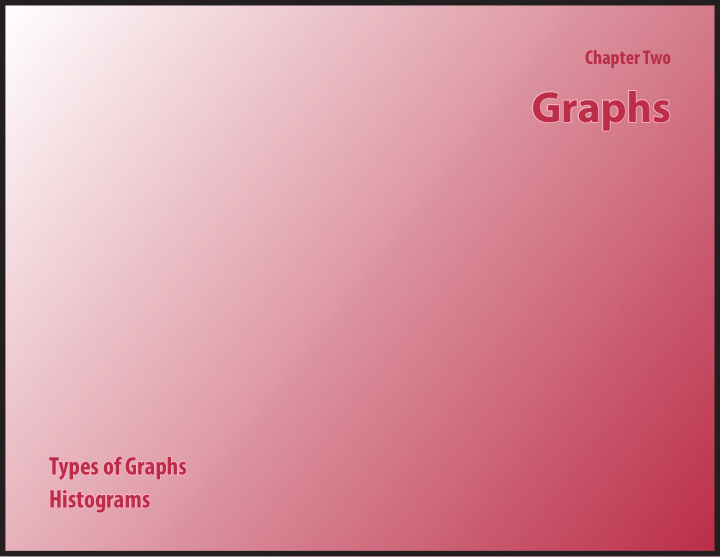



Chapter Two Graphs Types of Graphs Histograms
The Purpose of a Graph The purpose of a graph is to make results clear at a glance. Avoiding common pitfalls, such as those done by default in Microsoft Excel (shown below on the left), can help achieve this goal. Problem with default Excel graph Consequence no x -axis label; untitled categories not known what is being compared no y -axis label or title not known what is being measured y -axis doesn’t have appropriate range misleading comparison inconsistent decimal places distracting, unprofessional “Series1” confusing because it is meaningless Efgect of Noise on Recall 81.85 ¡ 81.8 ¡ 100% 81.75 ¡ 81.7 ¡ proportion of words recalled 75% 81.65 ¡ 81.6 ¡ 50% Series1 ¡ 81.55 ¡ 81.5 ¡ 25% 81.45 ¡ 81.4 ¡ 0% 81.35 ¡ quiet noisy group ¡1 ¡ group ¡2 ¡ background
Types of Graphs Graph Description Purpose When to use Bar Graph one bar for each to compare The independent variable is category averages, totals, categorical, such as car brand. or frequencies of categories Scatter Plot one dot for each to show the cor- Each participant provides two data point relation between numerical values, such as height and two numerical weight. variables Time Series Plot one dot for each to show a trend The independent variable is time point in time, over time on a timeline, such as year, and the connected with dependent variable is numerical, such line segments as rainfall. When there are two independent variables, one can be established on the x -axis normally and the sec- ond can be established by difgerent colors labeled in a legend.
Graph Examples Graph One independent variable Two independent variables Bar Graph 4.0 4.0 average GPA average GPA 3.0 3.0 2.0 2.0 1.0 1.0 0.0 0.0 male female male female fall Sex Sex spring Scatter Plot 4.0 4.0 Science GPA Science GPA 3.0 3.0 2.0 2.0 1.0 1.0 0.0 0.0 0.0 1.0 2.0 3.0 4.0 0.0 1.0 2.0 3.0 4.0 fall Math GPA Math GPA spring Time Series Plot 4.0 4.0 average GPA average GPA 3.0 3.0 2.0 2.0 1.0 1.0 0.0 0.0 ’14 ’15 ’16 ’17 ’18 ’19 ’14 ’15 ’16 ’17 ’18 ’19 fall Year Year spring
Histograms and Distributions A discrete distribution states each possible category and how common it is. A histogram is a type of bar graph in which the x -axis is a numerical scale and the y -axis shows the frequency (quantity) or relative frequency (proportion) of data in each category. Distribution Description Histogram Example Uniform Each category is equally 6-Sided Die Rolls % of rolls 20 common. 10 0 1 2 3 4 5 6 Bimodal The two most common % sold today Starbucks Drink Prices 40 categories are not next to each 20 other. 0 $0 $1 $2 $3 $4 $5 $6 Approximately Normal The distribution is Scores on Physics Test # of tests 20 approximately mound-shaped 10 and symmetrical. 0 40 50 60 70 80 90 100 Skewed The distribution has one or a Home Prices ($100,000s) 20 # sold few data far out on one specifjc 10 side. 0 0 5 10 15 20 25 30
Recommend
More recommend